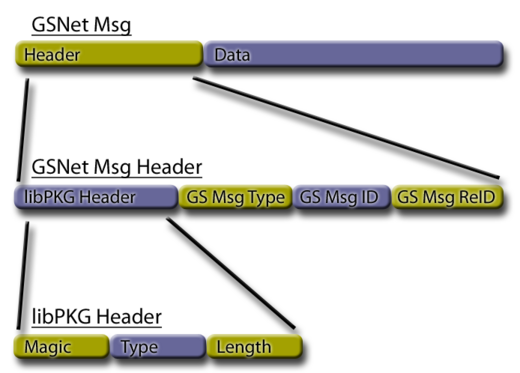Difference between revisions of "GeometryServiceNetworkProtocol"
(Fixed headline) |
(Message Length does not include magic/length values.) |
||
| Line 37: | Line 37: | ||
|style="border: 1px solid #666699;"|MessageLength | |style="border: 1px solid #666699;"|MessageLength | ||
|style="border: 1px solid #666699;"|int32 (4 bytes) | |style="border: 1px solid #666699;"|int32 (4 bytes) | ||
| − | |style="border: 1px solid #666699;"| | + | |style="border: 1px solid #666699;"|Does *NOT* include the magic or length, so is packet size - 8 |
|- | |- | ||
|style="border: 1px solid #666699;"|MsgType | |style="border: 1px solid #666699;"|MsgType | ||
Revision as of 13:05, 28 March 2011
| The Geometry Service Network (GSNet) Protocol is a TCP/IP based protocol designed to facilitate socketed communications between Geometry Service Nodes on a network. A Geometry Service Node is defined as any softwares that supports communication via the GSNet Protocol.
|
GSNet Msg (Visual) Breakdown
GSNet Msg Description
Header
The header of the GSNet Msg contains the information necessary for quickly determining authenticity, type and length. Geometry Service's network library, libNetwork, is built upon BRL-CAD's networking library: libPKG. This causes the header byte layout to look like this:
| Element | Length | Value |
| Magic1 | int16 (2 Bytes) | Always 0x41FE |
| Magic2 | int16 (2 Bytes) | Always 0x5309 |
| MessageLength | int32 (4 bytes) | Does *NOT* include the magic or length, so is packet size - 8 |
| MsgType | int16 (2 bytes) | |
| MessageUUID | String (Variable bytes) | |
| HasRegardingUUID | Boolean (1 byte) | |
| RegardingMessageUUID | String (Variable bytes) |
libPKG Part
Due to some C and C++ incompatibilities, the libPKG "Type" parameter is used as "Magic2" in the GSNet Protocol. This is due to libPKG's need for each network connection to have a callback table that maps NetMsg types to pointers to the appropriate NetMsg handler function. The GSNetwork library uses a publish/subscription scheme to route NetMsg. LibPKG strips off the libPKG header before calling the appropriate callback function, thus making per class deserialization extremely complex. To address these issues, the GSNetwork library routes NetMsg based on the "GS Msg Type" parameter rather than the "libPKG Type" parameter.
Table showing modifications described above:
| libPKG element | GSNet element |
| Magic | Magic01 |
| Type | Magic02 |
| Length | Length |
- Magic01: 2 bytes of data designed to ensure integrity of data and mark NetMsg starting point.
- Magic02: 2 bytes of data designed to ensure integrity of data and mark NetMsg starting point.
- Length: 4 byte integer that represents the number of bytes in the message from the end of this value to the end.
GSNet Part
- MsgType: 2 byte integer value that tells what type of message this is.
- MessageUUID: Standard UUID for this message. Currently stored as a string.
- HasRegardingUUID: Boolean flag that indicates whether there is a Regarding UUID or not.
- RegardingMessageUUID: Standard UUID that indicates this NetMsg is a response to another NetMsg.
Data
The Data load of a NetMsg is, obivously, the important and unique part. Data Loads can be as small as zero (in the case of a TypeOnlyMsg) or many kilobytes long.
Here is a list of NetMsg types and here is a list of Common NetMsg Exchanges.

